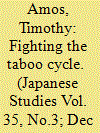| Srl | Item |
| 1 |
ID:
143819


|
|
|
|
|
| Summary/Abstract |
This article explores the historical significance of an incident reported in the international media in 2009 when Burakumin groups raised concerns about privacy and possible human rights abuses in relation to a new map service offered by Google. Reportage at the time indicated that historical maps containing references to outcaste settlements could be laid over contemporary maps to disclose the exact location of contemporary Buraku districts. A thorough examination of the incident, however, reveals a more complicated story. On the one hand the incident is clearly an example of ‘human rights activism’, an ongoing political strategy within the Buraku liberation movement to achieve permanent legal recognition of their status in the face of a state that has long resisted such demands. At the same time, however, the main features of this incident – silence, revelation, protest, and erasure – are also reoccurring themes within modern Buraku history that comprise what is described in the article as a taboo cycle. In their struggles for liberation, Burakumin have developed numerous strategies to combat the cycle as well as use it to their advantage.
|
|
|
|
|
|
|
|
|
|
|
|
|
|
|
|
| 2 |
ID:
123488


|
|
|
|
|
| Publication |
2013.
|
| Summary/Abstract |
This paper examines the way the outcaste head Danzaemon, or more precisely several individuals who successively bore that title, negotiated their place in the eighteenth-century Edo status order through official genealogical pronouncements. Eta and hinin groups became closely linked together in the political imaginary in Edo from around the beginning of the eighteenth century in an extraordinary legal battle that emerged between the leaders of these groups. The head of the former group, Danzaemon Chikamura, achieved a qualified victory in this struggle through genealogical posturing, positioning himself at the apex of an increasingly well-defined Edo outcaste order. By the second half of the eighteenth century, the privileged place within the order held by the next Danzaemon came under renewed pressure from a new generation of hinin. As a result, Danzaemon Chikasono made an attempt to rearticulate the grounds for his status through a different kind of genealogical statement. This article, using the official correspondence between Danzaemon and the Edo City Magistrate, examines the distinctive features of the genealogical imaginations of these two outcaste leaders in order to reveal the ways they negotiated their place within the Edo outcaste order.
|
|
|
|
|
|
|
|
|
|
|
|
|
|
|
|